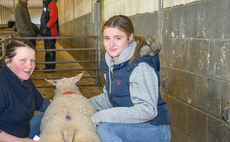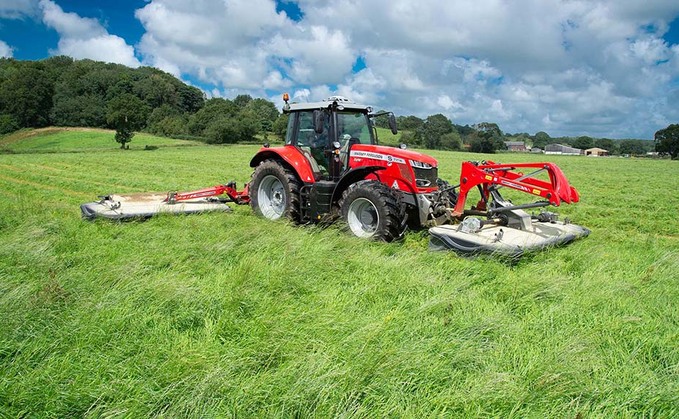
Representing an all-new mower design for Agco, we try out the latest additions to Massey Fergusons mounted mower-conditioner range. James Rickard reports.
Faced with a heavy crop of grass to tackle, not to mention some fairly wet fields, this years second cut provided the ideal set of challenges to try out Massey Fergusons latest mowers.
Those of you with a good memory may remember that Massey Ferguson, and its sister brand Fendt, inherited a full range of grassland and forage equipment when parent company, Agco, took on 100 per cent ownership of German-firm Fella back in 2011.
The acquisition included an extensive line-up of mowers, tedders and rakes. While many of the products since the initial purchase have undergone updates and tweaks, it is the mowers which have recently seen a large share of development.
This includes our test subjects, the front-mounted DM 316 FQ-KC and the rear-mounted DM 316 TLV-KC, which both feature a new bed style, suspension layout and hood design.
These new models are currently additions to MFs mower range, with more new-style models to follow, eventually replacing existing models.
Deciphering the model numbers reveals DM stands for disc mower, 316 represents the 3.1m cutting width and its six discs, while KC means they are equipped with a tine conditioner. FQ is the type of front mower, which in our case was a suspended/pull type, while TLV refers to the rear mowers turbo lift suspension and vertical folding.
To find out more about the mowers, we paired them with a 200hp MF 7718S tractor and set to.
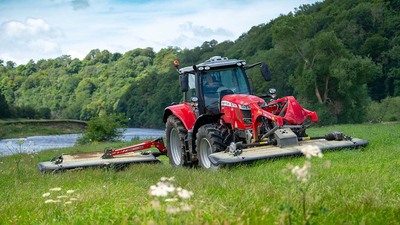
Specifications
- Test models: DM 316 FQ-KC (front mower), DM 316 TLV-KC (rear mower)
- Cutting widths: Both 3.1m
- Number of discs: Six each
- Conditioner type: Sprung, steel tine
- Suspension type: Hydro-pneumatic
- Power requirement: 75hp for the front, 115hp for the rear
- List price: £18,773 for the DM 316 FQ-KC, £18,459 for the DM 316 TLV-KC
Mower bed
Mower bed
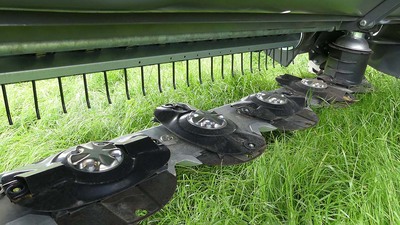
One of several major developments to the mowers is the shift from a shaft-driven bed to a more conventional and popular spur gear design. Interestingly, the only other major manufacturer to use shaft-driven beds was Lely - also bought by Agco.
While shaft drive is efficient, the ‘cheese wedge' shape of the bed often meant the cutting discs were pitched a long way forwards, sometimes producing an uneven cut. Conversely, using gear-drive means bed construction can be flatter and slimmer, helping the bed get under the crop and achieve a more even cut.
Not seeing these two differing bed designs working side by side, it is hard to quantify the difference between the two. However, the new style of bed did do a good job in our wet and undulating conditions.
MF says its current shaft-drive beds will eventually be phased out in favour of gear-drive. It is also an area of the mower which makes use of Agco's engineering facilities and expertise from around the world. In this case, the gears are made at its Agco Power (formerly Sisu) engine factory in Finland.
For both the front and rear mower, the cutting height can simply be adjusted by the top link. Optional skids can also be added to the underside of the beds, to alter cutting height further.
Disc design
Disc design
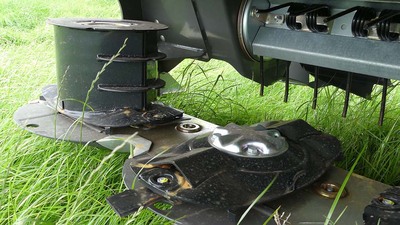
Taking care of cutting are six large diameter discs. Again, this is another area which takes inspiration form Agco's other products - this time, its self-propelled Hesston mowers/windrowers.
Compared to most mowers of this cutting width on the market, which would normally have about seven or eight discs, the discs do look big. MF says these are ideal for getting under laid crop and also provide a generous overlap of 123mm between each disc, enabling a cleaner cut.
Apart from the two central discs, all discs rotate towards the centre. This is said to help the flow of grass through the mower and towards the conditioner. Aiding this are large ‘top hats' on the outer discs and raised pieces of steel on top of discs two and four. These raised pieces are designed to create more draught and, therefore, lift of the crop. Our conditions certainly tested this large disc design, but, overall they performed well.
Despite the look of the nut above each blade on the disc, blades are quick release-type, with only a simple tool needed to swap them. Blades are also double edged, allowing them to be ‘flipped' and used again, and both mowers feature convenient blade storage.
Conditioner
Conditioner
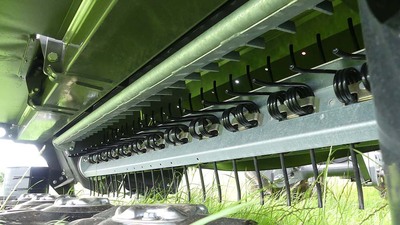
Conditioner options extend to tine, roller or none. While the latest MF conditioner design is similar to that of the original Fella machines, they do differ quite substantially to everything else on the market.
Rather than swinging steel tines or fixed nylon tines, as are often used on conditioners, MF's conditioners look like something you might find on an old Bamford Wuffler.
It makes a lot of sense too, according to the manufacturer, which says it is aiming to bruise the crop, but without cracking it and losing valuable sugars. It also adds, this should make the grass less absorbent, should it rain again.
Conditioner
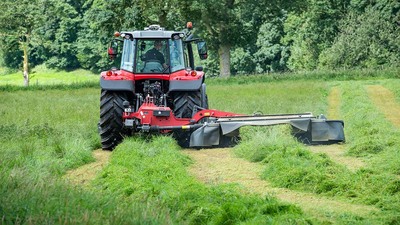
Working alongside another make of mower with nylon tine conditioner, it was clear to see the difference in conditioning action, with the MF's swath a lot fluffier and airier, standing taller with a squarer shape. It also made the swaths easier to rake.
How much of a difference this type of conditioning will have on the nutritional value of the silage is still up for debate, but it did look impressive.
The conditioner is made up of fat, sprung, steel tines mounted in pairs along four rows around a shaft. Working against the conditioner is a row of steel fingers. These fingers can be easily pivoted closer or further away from the conditioner by a lever, altering the level of conditioning.
Swath width
Swath width
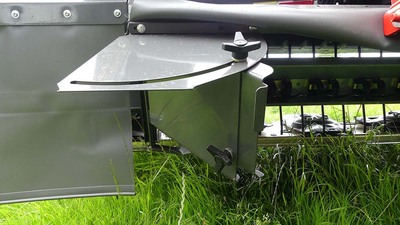
Swath width adjustment on both of our test mowers was straightforward, done via deflector boards.
The front mower's deflectors also telescope in and out, helping crop clear the front tyres of the tractor.
As an option, individual spreader vanes can be specified, for a more even spread. These can also be adjusted without the need for tools.
Driveline
Driveline
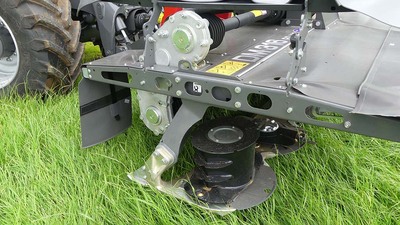
While drive to the rear mower is all inputted from one end of the mower, with drive split via a gearbox to the bed and conditioner, drive to the front mower is split from the main central gearbox on top of the mower. From here, one shaft drives the bed and one drives the conditioner.
For both mowers, this means there are no belts to worry about. However, conditioner speed is fixed, with no ability to change gear. The only conditioner adjustment comes from the movable fingers (see conditioner panel). It is likely, though, for this type of conditioner, speed adjustment is not necessary, but you may find out otherwise in different conditions.
Main driveline protection comes from slip-clutches, while individual disc protection is afforded by shear shafts within the disc hubs.
Access to the mowers is decent. On both mowers, the front portion of the hood folds upwards, affording good access to the bed, while plastic end-guards are really easy to fold in and out for work and transport positions.
Suspension
Suspension
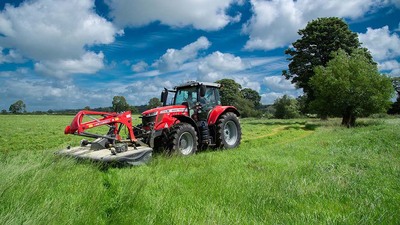
Both the front and rear mowers feature new suspension designs. The front mower's suspension unit, in particular, looks radically different from Agco's/Fella's previous designs, with a more centralised frame which affords a virtual ‘pulling' action of the mower.
As such, the mower has been designed to follow contours better. And having tried out a Fella-badged pull-type front mower some years ago, it is a big improvement.
Its +/-13 degrees of left to right travel and its front to back travel of +15 and -6 degrees, along with 400mm of lift/upward travel and 250mm of downward travel compare well to other models on the market. You can also specify a side shift mechanism, which helps to avoid ‘misses' when turning.
Our initial concern over the front mower was the seemingly large distance from the front of the mower bed to the centre of the tractor's front axle. It looked like it could be prone to ploughing. On the whole, this was not the case, and the mower managed to climb most ridges with minimal scalping. It also followed undulations well, and a conservative suspension pressure setting meant smearing in our wet conditions was also minimal.
Suspension
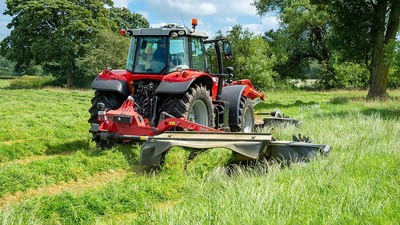
As for the rear mower, it is suspended from the centre of the bed by a single arm. This arm also features a little ram which is connected to the mower, which pressurises when the main lift ram is used. This keeps the mower rigid when lifted and prevents it from swinging around. Similar to the front mower, the rear also followed the ground well.
Suspension on both mowers is hydro-pneumatic. This can simply be adjusted via a tap on an accumulator. The latter re-calibrates automatically every time the mowers are lifted.
To operate the mowers, the front needs one, single-acting hydraulic service to lift/lower, while the rear needs one, single-acting for lift/lower and one double-acting for folding the mower.
Framework
Framework
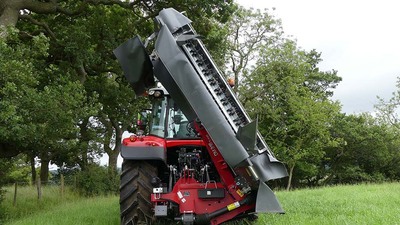
As mentioned, the front mower does stick out a long way forwards, which requires a bit of extra caution on the road. It can also make turning into gateways off a narrow lane a bit of a challenge.
The rear mower, on the other hand, folds very neatly. Thanks to a dedicated ram (not the lift ram), this sees the mower bed fold past the tractor's centreline to 120 degrees, bringing the centre of gravity closer to the middle, rather than all the weight to one side.
For protection, the rear mower features a break-back mechanism which sees the mower swing backwards and upwards, should it hit an object. The level of protection can also be adjusted, making it easier or harder to break-back.
To park up the front mower, there are no stands to mess with - you just have to lock the suspension framework and it will rest on its bed. It also has no A-frame, which some may miss, but it does mean the mower is mounted that little bit closer to the tractor. You could also argue that A-frames have been outgrown by some of the latest tractors and mowers and have become a weak link in the mounting chain.
Framework
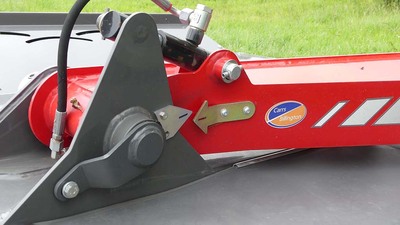
The rear mower can be ‘dropped' off either in its working or transport position. When unhooked in its working position, a stand is simply unfolded. To store in its folded position, an extra stand need attaching. Unfortunately, this stand cannot be stored on the machine, but it probably means you have got less chance of losing it.
When hooking the rear mower back up, getting the linkage height right is easier thanks to arrows, positioned on the hood and lift arm, which line up when in the right position. No need for a tape measure at the rear.
For flexibility, the rear mower can be hitched to the tractor in one of two linkage positions, with the ability to mount the mower further to the right, matching it up with a wider front mower.
Verdict
Overall, the mowers were definitely a pleasant surprise and have certainly come a long way since the Fella-branded machines.
It is clear to see Agco has put a lot of effort in the redesign of its future mowers. And if our test subjects are anything to go by, it has set some good foundations on which to expand the line-up.
As is all too often the case when silaging, our conditions during the test were not ideal. However, with a bit of tweaking to suspension and cutting heights, the mowers performed well.
While we cannot test for longevity, the mowers are worth a look and are now up there with the major makes.
























